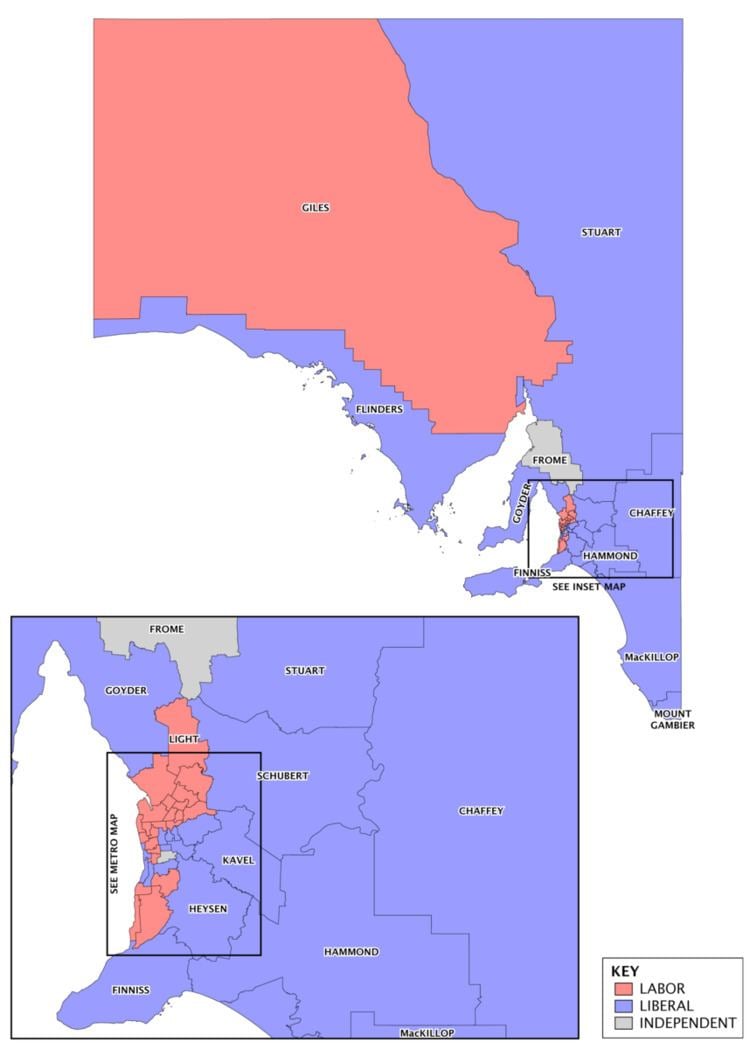 | ||
In South Australia, one of the states of Australia, there are many areas which are commonly known by regional names. Regions are areas that share similar characteristics. These characteristics may be natural such as the Murray River, the coastline, desert or mountains. Alternatively, the characteristics may be cultural, such as common land use. South Australia is divided by numerous sets of regional boundaries, based on different characteristics. In many cases boundaries defined by different agencies are coterminous.
Contents
- Informal divisions
- Australian Bureau of Statistics
- Statistical Divisions
- Weather forecasting
- South Australian Government regions
- Adelaide metropolitan area
- Greater Adelaide area
- Country regions
- Protected areas
- Natural resource management
- Department of Primary Industries Regions
- Electoral districts
- Local government
- Biogeographic regions
- Tourist regions
- Wine regions
- References
Informal divisions
Convention and common use has divided South Australia into a number of regions. These do not always have strict boundaries between them and have no general administrative function or status. Many of them correspond to regions used by various administrative or government agencies, but they do not always have the same boundaries or aggregate in the same way. The generally accepted regions are:
Most of the other regional divisions of the state use a combination of these same labels, sometimes grouped, and sometimes with precise boundaries that might be slightly different in each case.
Australian Bureau of Statistics
The Australian Bureau of Statistics has multiple regional structures for which it analyses and reports data. These regional structures derive from the Australian Standard Geographical Classification (AGSC). The AGSC defines at the very smallest level, the Census Collection District (CCD). These CCD's aggregate to form the Statistical Local Area (SLA), which is the common base unit for each of the larger regional structures. The boundaries of the SLA are designed to be typically coterminous with Local Government Areas unless the LGA does not fit entirely into a Statistical Subdivision (SSD), or is not of a comparative nature to other LGA's. Bureau of Statistics provides statistics for Local Government Areas, as well as three other statistical structures: Statistical Divisions, Statistical Regions, and Statistical Districts.
Statistical Divisions
Statistical Divisions (SD) form the main structural hierarchy of statistical analysis. These regions are structured to provide a broad range of social, demographic and economic statistics. The basis for the boundary delineations center on socioeconomic criteria. The eight Statistical Divisions in South Australia are:
Weather forecasting
The Australian Bureau of Meteorology (BOM) provides forecasts and observations within South Australia and its adjoining waters using the following 15 land areas which are known as “districts” and 11 areas known as “coastal waters” which are located within both the state’s jurisdiction and Australia’s maritime jurisdiction:
South Australian Government regions
South Australian government departments and agencies with some exceptions use a uniform set of boundaries to describe the extent of 12 administrative regions within the state which are used to “develop and improve reporting, planning and service delivery systems”.
Adelaide metropolitan area
Greater Adelaide area
Country regions
Protected areas
South Australia's protected areas are grouped into 11 regions:
Natural resource management
The Natural Resources Management Act 2004 established the following Natural Resources Management (NRM) regions “to give ownership of and responsibility for NRM to regional communities”: Adelaide and Mount Lofty Ranges, Alinytjara Wilurara, Eyre Peninsula, Kangaroo Island, Northern and Yorke, South Australian Arid Lands, South Australian Murray-Darling Basin and the South East.
Department of Primary Industries & Regions
The Department of Primary Industries & Regions (PIRSA) supports economic development in the non-metropolitan regions of South Australia. It identifies seven non-metropolitan regions:
Electoral districts
South Australia is divided into 47 electoral districts each of which elects a single member into the South Australian House of Assembly (also called the lower house of parliament).
It is divided into eleven electoral divisions which each elect a member into the House of Representatives of the Parliament of Australia. These divisions are:
The federal divisions overlay the state electoral districts, but do not aggregate them. A state district may be divided amongst two or more federal divisions.
Local government
South Australia's Local Government Areas (LGAs) have grouped themselves into seven Regional Local Government Associations. These are:
Biogeographic regions
The Interim Biogeographic Regionalisation for Australia (IBRA) is a biogeographic regionalisation of Australia; divided into 89 bioregions and 419 subregions. Each region is a land area made up of a group of interacting ecosystems that are repeated in similar form across the landscape. Regions and subregion cross state and territory boundaries. The bioregions that are located wholly or partly in South Australia are:
Tourist regions
South Australia has been divided into the following 12 tourism regions for the purpose of coordinating both government and tourism industry efforts to promote South Australia as a visitor destination: Adelaide, Adelaide Hills, Barossa, Clare Valley, Eyre Peninsula, Fleurieu Peninsula, Flinders Ranges and Outback, Kangaroo Island, Limestone Coast, Murray River, Lakes & Coorong, Riverland and Yorke Peninsula.
Wine regions
The wine industry has a number of defined wine zones and regions, however they do not cover the entire state (especially as some areas are not suitable for growing grapes). These are controlled as Australian geographical indications by the Australian Grape and Wine Authority. As of March 2015, the following zones are in use in South Australia: Barossa, Far North, Fleurieu, Lower Murray, Limestone Coast, Mount Lofty Ranges and The Peninsulas.
